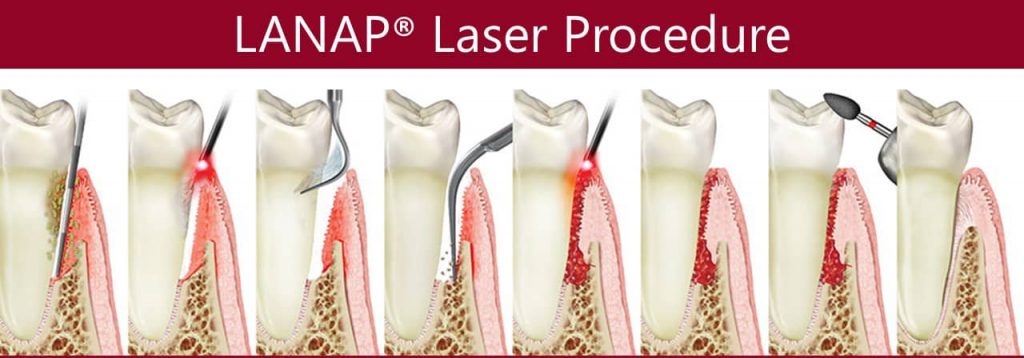Lasers: Less Is More
If your doctor informed you about a practically painless surgery that used a laser instead of a scalpel, would you be more compelled to try it? For those who may have put off surgery out of fear, lasers have changed the face of medicine. And the same goes for the use of the LANAP laser in dentistry.
Unfortunately, far too many people don’t get the gum disease treatment they need out of fear of going under the knife. Without dental treatment, patients face significant dental health risks, such as tooth and jawbone loss. But a new procedure called LANAP is helping to change the grim outlook anxious dental patients once faced.
The LANAP Laser
LANAP, which stands for Laser Assisted New Attachment Procedure, uses a laser to perform periodontal surgery once only reserved for a scalpel. Developed by Millennium Dental Technologies, Inc., LANAP surgery is successful in treating gum disease with minimal trauma to the mouth. Traditional gum surgery uses a scalpel to decrease pocket depth and remove the infection — and unfortunately, some healthy tissue is destroyed in the process. Stitches are then placed to reattach the gums to the bone and assist in healing.
The LANAP laser removes the infection from beneath the gum line without compromising healthy gum tissue. LANAP is considered a regenerative procedure: Tissue is not reduced and bone is actually regenerated. The LANAP laser recognizes pigmentation, only destroying bacteria and infected gum tissue, which are darker in color than healthy gums. The LANAP procedure also helps connective tissue and bone form between your teeth and gums, which could help minimize the chance of the infection returning.
The LANAP Procedure
The Laser Assisted New Attachment Procedure consists of several simple steps:
LANAP Preparation — First, your dentist may take X-rays or probe the area to determine the depth of your pockets and the extent of the infection.
Anesthesia — Local anesthesia may be used to keep you from feeling any discomfort. LANAP is non-invasive and normally doesn’t require any other form of sedation. But if you are an extremely fearful patient, talk to your dentist about your sedation dentistry options.
LANAP Procedure — Once you are numb, the LANAP laser is inserted between your teeth and gums to remove infected tissue and bacteria. The LANAP laser is extremely tiny (about the thickness of three hairs), designed to fit easily between your gums and teeth.
Post-LANAP Surgery — Once the area is thoroughly cleaned, the heat from the LANAP laser seals the gums to form a blood clot. This helps block bacteria from re-entering and re-infecting the area.
The LANAP procedure usually consists of two 2-hour sessions and two follow-up visits. You can compare LANAP to traditional surgery, which usually takes four surgical procedures and several follow-up visits to remove stitches.
Why Choose LANAP?
LANAP was designed to meet the growing need for pain-free dentistry. With LANAP, there are no scalpels or sutures and healing time is greatly reduced. The patient feels little to no discomfort during and after the LANAP procedure, which could reduce the need for post-operative prescription medications. Recovery from LANAP surgery often takes less than a day rather than the two to four weeks required for traditional surgery; many patients are able to return to work soon afterwards. Your dentist may also recommend that you follow a soft food or liquid diet for one to two days, as opposed to several weeks following gum surgery.
Other benefits of using the LANAP laser include:
– Less time spent in the dental chair
– Less mouth trauma caused by the traditional scalpel and sutures procedure
– Less pain, bleeding and swelling
– Easier healing and a faster recovery
– Improved, longer-lasting results
One Final Note on LANAP
The LANAP laser has not entirely eliminated the use of the scalpel. You may still need traditional gum surgery for some procedures. And while LANAP surgery may reduce your progression of gum disease, you still have to practice good oral hygiene and have regular dental visits to help maintain your results.

